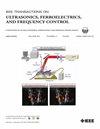Assessing Ultrasound Safety: A Method for Correlating Stimulus Parameters With MI and TI
IF 3.7
2区 工程技术
Q1 ACOUSTICS
IEEE transactions on ultrasonics, ferroelectrics, and frequency control
Pub Date : 2025-03-16
DOI:10.1109/TUFFC.2025.3570878
引用次数: 0
Abstract
Diagnostic ultrasound safety indices, such as the mechanical index (MI) and the thermal index (TI), serve as approved risk estimators of bioeffects that can result from an ultrasound stimulus. However, especially in ultrasound-based indirect therapeutic applications, only the MI is reported while the TI is overlooked, possibly due to its complex calculation. To simplify the calculation, we present an analytical-numerical method for computing the TI, restricted to the −6-dB region of the ultrasound beam, based on equations provided by the International Electrotechnical Commission (IEC) standards. Central to this calculation is the assumption of a linearly propagating ultrasound wave with minimal nonlinear distortion. This assumption was verified by COMSOL simulations and hydrophone measurements in a two-layer setup consisting of water and a tissue-mimicking phantom (TMP) for a single-element, spherically focusing transducer with a central opening driven at a frequency of 950 kHz. For this configuration, the peak-rarefactional pressure (PRP) was evaluated up to 1.5 MPa. To facilitate the immediate assessment of ultrasound safety, MI and TI were mapped into characteristic diagrams, correlating them with pulse durations (PDs) between 0.1 and 3.5 ms at a pulse repetition period (PRPP) of 0.1 s and PDs between 0.01 and 0.35 ms at a PRPP of 0.01 s. These diagrams serve as a practical tool for determining whether an ultrasound stimulus adheres to diagnostic safety limits for MI and TI.超声安全性评估:一种将刺激参数与心肌梗死和心肌梗死相关联的方法。
诊断性超声安全指数,如机械指数(MI)和热指数(TI),作为经批准的超声刺激可能导致的生物效应的风险估计。然而,特别是在基于超声的间接治疗应用中,可能由于其复杂的计算,只有MI被报道,而TI被忽视。为了简化计算,我们基于国际电工委员会(IEC)标准提供的方程,提出了一种计算TI的解析-数值方法,该方法仅限于超声波束的- 6db区域。这个计算的核心是假设线性传播的超声波具有最小的非线性失真。COMSOL模拟和水听器测量验证了这一假设,水听器由水和组织模拟模体(TMP)组成,用于单元件球形聚焦换能器,其中央开口驱动频率为950 kHz。对于这种配置,峰值反应压力(PRP)被评估为1.5MPa。为了便于立即评估超声安全性,将MI和TI绘制成特征图,并将它们与脉冲重复周期(PRPP)为0.1 s时0.1-3.5ms的脉冲持续时间(PD)和PRPP为0.01 s时0.01-0.35ms的脉冲持续时间(PD)相关联。这些图作为确定超声刺激是否符合心梗和TI诊断安全限度的实用工具。
本文章由计算机程序翻译,如有差异,请以英文原文为准。
求助全文
约1分钟内获得全文
求助全文
来源期刊
CiteScore
7.70
自引率
16.70%
发文量
583
审稿时长
4.5 months
期刊介绍:
IEEE Transactions on Ultrasonics, Ferroelectrics and Frequency Control includes the theory, technology, materials, and applications relating to: (1) the generation, transmission, and detection of ultrasonic waves and related phenomena; (2) medical ultrasound, including hyperthermia, bioeffects, tissue characterization and imaging; (3) ferroelectric, piezoelectric, and piezomagnetic materials, including crystals, polycrystalline solids, films, polymers, and composites; (4) frequency control, timing and time distribution, including crystal oscillators and other means of classical frequency control, and atomic, molecular and laser frequency control standards. Areas of interest range from fundamental studies to the design and/or applications of devices and systems.

 求助内容:
求助内容: 应助结果提醒方式:
应助结果提醒方式:


